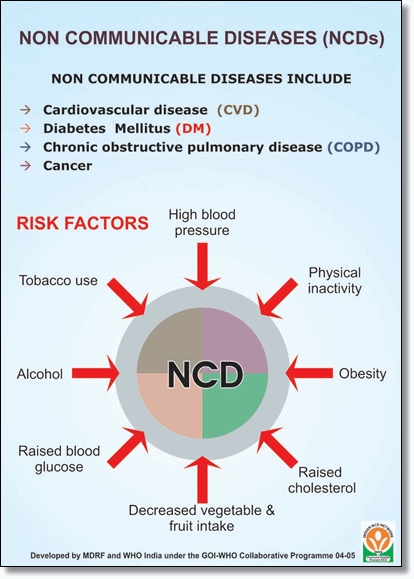Risk Factors for Noncommunicable Diseases in Africa

 |
In our Region, the main NCDs include cardiovascular diseases, chronic respiratory illnesses, diabetes, cancer, and the consequences of violence and road traffic accidents. Addressing the common risk factors can prevent these diseases to a great extent.
Sound health policy and preventive actions on the risk factors and their determinants taken at government, community and individual levels have the potential to halt or reverse the rising trend of NCDs.
In 2008, about 2.8 million deaths in the African Region were attributed to NCDs. This figure is projected to increase by 27% over the next 10 years.
About a third of NCD deaths occur prematurely during the most productive years of life, and this negatively impacts economic development. Most of the risk factors associated with these diseases are behavioural and lifestyle related and, therefore, amenable to change. For example, at least 80% of deaths from cardiovascular diseases, diabetes, and chronic respiratory diseases, and 40% of deaths from common cancers are preventable.
Non communicable diseases pose a serious threat to the health and welfare of people in the African region. These threats are related to very well established risk factors.
Tobacco use continues to be the leading cause globally of preventable deaths. It kills nearly 6 million people annually, and causes hundreds of billions of dollars of economic loss globally each year. Low and middle-income countries are most affected. The prevalence of tobacco use among youth in the African Region ranges from 6.6% to 36.1%. In addition, about 48% of youth in the region are exposed to second-hand tobacco smoke in public places thus making them susceptible to respiratory diseases.
With regards to alcohol, it is the third leading global risk factor for disease and disability. Four percent of all deaths worldwide are attributable to alcohol. Harmful use of alcohol has acute consequences, including road traffic accidents and violence particularly against children and intimate partner, child neglect and abuse, absenteeism in the work place among others. Alcohol is further associated with cancers, cardiovascular diseases, liver diseases, neuropsychiatric disorders, traumas, weight gain and obesity; and these may lead to disability and death.
According to the most recent estimate by WHO, in the African Region, 30% of the population drink alcohol regularly. Overall adult per capita consumption of pure alcohol is 6.2 liters. The statistics show that men drink more than women - 3.0 liters for women and 9.5 liters for men on average. At global level, the average per capita consumption is also 6.2 liters. Meanwhile, among people who drink alcohol, the average per capita consumption stands at 19.2 liters (ranging from 1.1 to 37 liters). Therefore, the two characteristics of alcohol consumption in Africa are the high level of abstention (averaging 70%), and the high volume consumed per drinker.
Therefore, we can assume that, by increasing the level of abstention and reducing the volume of consumption among drinkers, we could reduce the harm associated with alcohol.
Concerning unhealthy diet, this is a major risk factor for non-communicable diseases. In many countries of the Region, stunting and underweight among children as a result of food shortages and inappropriate feeding patterns remain issues of public health concern. However, overweight and obesity are on the increase especially in urban areas. Due to lifestyle changes, people are moving away from traditional foods to diets rich in fats, sugars and salt, but low in fruits and vegetables. Data gathered from STEPS surveys in the African region in the past 10 years show rates of obesity ranging from 1–31% among adults with higher percentages among females.
Physical inactivity is an equally important risk factor that needs to be addressed, given the high rates of urbanization. Within countries, high rates of physical inactivity are seen among women and children, in particular. WHO recommends that adults undertake 150 minutes per week of physical activity, for NCD prevention and maintenance of health.
The risk factors for NCDs are driven by modern life styles and behaviors -- in relation to which policy makers and people are, in general, poorly informed. Governments and parliaments -- together with representatives of civil society organizations and consumer associations – have the responsibility to develop policies, set norms, and pass and enact legislation that protect public health and give individuals reliable facts to make informed choices.
All stakeholders have a collective responsibility to work together to promote and protect public health. WHO have established a strong foundation for moving this agenda forward jointly with Member States and partners. Allow me to highlight a few:
•The WHO Framework Convention on Tobacco Control (WHO FCTC) that has been ratified or acceded by 41 of our 46 Member States in the Region;
•Global and regional Strategies to reduce harmful use of alcohol;
•the Global Strategy on Diet, Physical Activity and Health;
•the 2012 Strategy for health promotion in the African Region, which calls for innovative financing of health promotion, including a special levy on alcohol and tobacco.
The majority of NCDs is not diagnosed nor are they treated. There is a need to strengthen the capacity of the health services to tackle the clinical aspects of chronic diseases using the primary health care approach –including ensuring qualified staff, and making relevant medicines and technologies accessible. Today’s risk factors are tomorrow's diseases.
By Dr. L. G. Sambo
WHO Regional Director.
